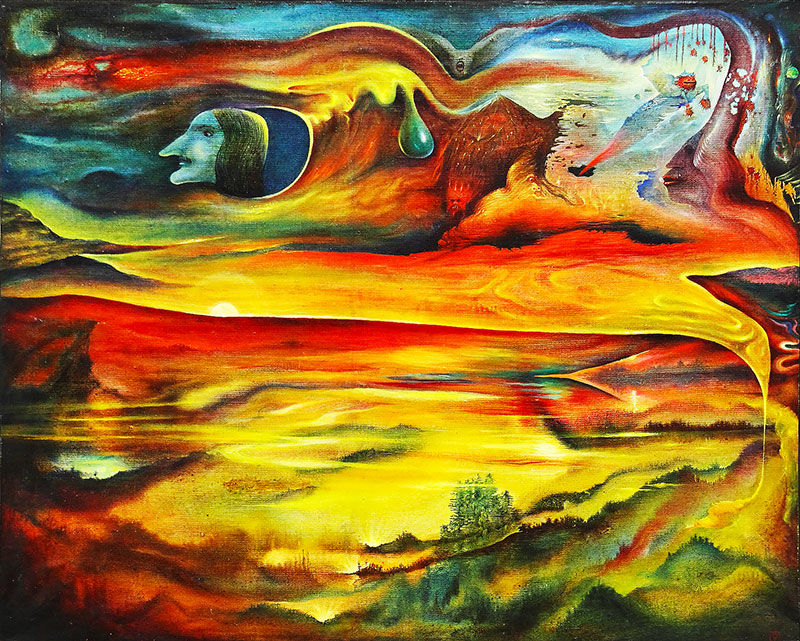Diversity in Turkmen art
An exhibition in Ašgabat two prominent local artists-the "realist" Aleksandr Kaširsky and the "surrealist" Ljudmila Nabirkina-offer an inspiring example of how culture can introduce people to contact with reality, providing new tools for its understanding.
Ašgabat (AsiaNews) - Art lovers and critics are particularly impressed by the exhibition organized in the hall of the Union of Turkmenistan Artists in Ašgabat, where a multifaceted dynamism of creativity can be observed in a country often crystallized in its forms and symbols. The exhibition offers a very stimulating "duet" of two important Turkmen artists who are quite different from each other, such as the "realist" Aleksandr Kaširsky and the "surrealist" Ljudmila Nabirkina.
Initially Kaširsky thought of exhibiting only his "Representations of the Greats of Turkmen and Western Culture in Bronze and Wooden Bas-reliefs" on the occasion of his 70th birthday, but in the process of assembling the exhibition, several canvases depicting moments and places of everyday life, with Ašgabat's old streets, courtyards and fountains, where people and animals live together in peace and friendship, were also included. The paintings aroused nostalgic emotions in the residents of the capital, in remembrance of "our beloved and comfortable Ašgabat" of times past.
Kaširsky had begun working artistically with metals in the 1970s as a decorator of companies and offices, and then went on independently to produce dozens of "medal art" portraits of famous people from East and West. Thus one can admire the vivid features of Bach, Chopin, Paganini, Turkmen composer Veli Mukhatov and the "Turkmen nightingale," singer Maja Šakhberdjeva, along with many others. The author is particularly proud of the portraits of the great writer Kajum Tangrjkuliev, and the well-known journalist and photographer Alikper Gusejnov.
At Aleksandr's own initiative, Nabirkina was also invited to participate, after a long courtship. The latter's works had caught everyone's attention in the late 1980s and early 1990s because of their originality, which one struggles to limit to a single stylistic definition. Ljudmila is able to move from very realistic images and portraits to others that are astonishing in their enigmatic nature. Very essential and laconic faces, but also filled with symbolic imagery, with very thick, raised strokes of paint of various colors, these works often give one pause for thought, or trigger the imagination, such as the 1982 "Charlie Chaplin," similar to a child's drawing, and a look in which the whole world is reflected.
Among the most impressive are "The Mirror," which "when I cry, he doesn't laugh," and the tragic monochromatic "Pushkin" in a sad and dramatic tone about the poet's untimely death. The 1988 "Scene in the Presence of Gogol," on the other hand, is very varied, conveying the mystical feeling of spasmodic waiting before the pagan festival of Ivan Kupala, the shortest night of the year, with all the ancient folklore of Malorossiya-Ukraine. the profile of the greatest Russian-Ukrainian writer "sails" through the clouds preceding sunset, reminding the viewer of the deep and undefined relationship between territories and peoples today plunged into the horror of war.
At the beginning of the 2000s, Nabirkina turned to "interior photos," images of escape from reality in motion, after which the artist took refuge in silence and solitude for a long time. It was precisely Kaširsky who gradually succeeded in bringing her back into the community of artists and Turkmenistan's socio-cultural life, associating her with his exhibition more than 30 years after Ljudmila's last public exhibition. She herself wanted to name her section of the exhibition with the title Soprikosnovenie, "Getting in Touch," to signify together the friendship of two artists and the mission of art, that of introducing people to contact with reality, providing new tools for its understanding.
13/02/2017 17:18
30/12/2024 12:56
13/06/2023 09:46
19/08/2022 09:59
25/11/2021 10:52







.png)










